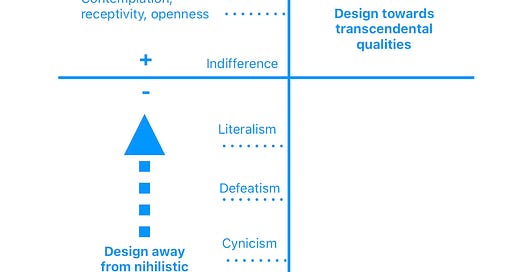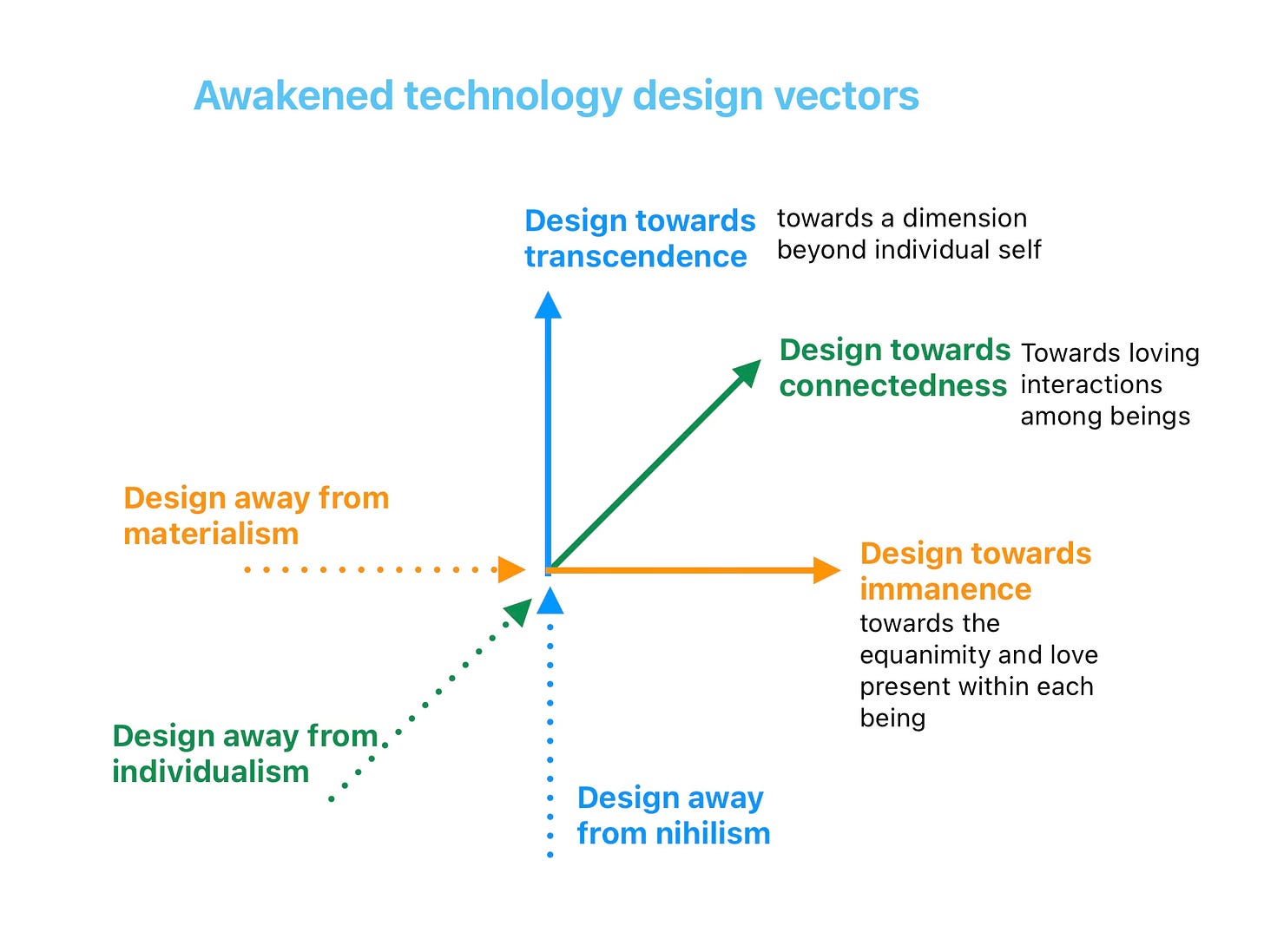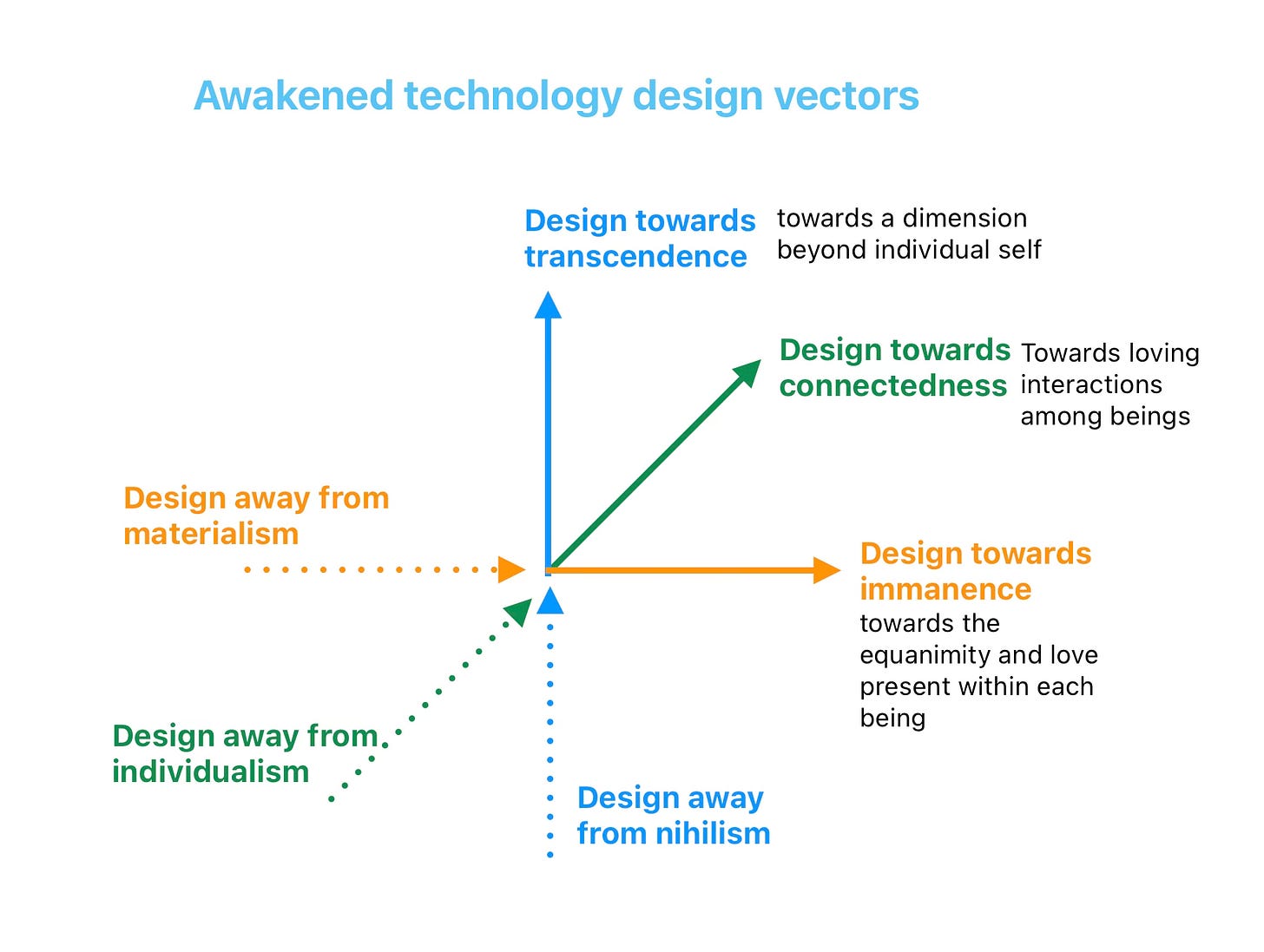What would transcendental technology design look like?
Transcendence: the Y axis of where technology and spirituality can meet
This is the second in the series of four posts where I explore the conceptual intersections of technology and spirituality. The first, introductory post, covered Professor Gabriel Fernandez-Borsot’s premise, i.e. that the concepts of transcendence, immanence, and relationality can help us in reframing how we think about the ways that technology and spirituality relate to each other.
As an application of Fernandez-Borsot’s work, I introduced the idea of ‘awakened design’ that also draws from the principles of critical technical practices and spiritual traditions. As far as I know, there are no other innovation or technology frameworks that attempt to include spiritual aspects to the technology design and development process. To conceptualise the design space, I am translating the three concepts — transcendence, immanence, and relationality — to the three axes: x, y, and z, respectively.
Together, the axes demarcate an aspirational design space, towards transcendental, immanent, and relational qualities, and away from a negative design space that reflects nihilist, cynical, individualistic, and materialist ones. The illustration above summarises the idea, and today I will start breaking down the nuances along the individual axis.
Some of us attribute transcendental qualities to technologies, to the extent that movements have emerged around such dispositions. For example, transhumanism promotes technological body and mind enhancements. Practices of organised religion that have moved online have been dubbed ‘cyber-spirituality’. Silicon Valley tech entrepreneurs are considered ‘gurus’, virtual reality enables ‘transformative experiences’, and so on.
However, such associations and activities may arise from needs to optimise convenience, be it through physiological augmentations, maximising unsustainable growth and profit, or seeking entertainment for the restless mind. At best, they are “near enemies of the truth” - something that appears similar to transcendental qualities but actually undermines them.
Towards transcendental technology development
Fernandez-Borsot refers to philosopher Martin Heidegger’s writings about technology and proposes that building technology is often about ‘forcing out’ something from nature: forcing plants to grow fast and at scale, forcing electromagnetic waves to vibrate so that we can send email, and so on. With each such manoeuvre, using technology, we aim to reproduce the same conditions over and over again for a certain purpose with “extreme repetitiveness and systematicity” because nature itself cannot. Or, it does not find such exertion sustainable, for far-reaching reasons that the technological mind has not historically had the patience to think about.
This human power over nature, ‘unveiling’ nature’s hidden possibilities for human exploitation to produce things that appear magical, is something that captures our minds:
By building ships, we reveal the sea as “shippable,” and by building cell phones, we show the universe as intimately interconnectable beyond distance. - Gabriel Fernandez-Borsot (2023), p. 12.
The process of developing technology is at least equally compelling as the technological end product. “It is this unveiling, brought about by technological development and presented to the users as a growing range of possibilities, that explains the attraction that technological innovations exert on young people”, Fernandez-Borsot continues.
Therefore, I see that any attempt to instil an awakened perspective to technology design and development needs to focus on the process rather than the outputs. Spending time pondering on how to make a transcendental smartphone feels ridiculous and counter-productive. Instead, we can think about how technologists with transcendental aspirations might make future communication devices that reflect transcendental qualities:
the lesson that the transcendent axis of spirituality brings in regard to technology is that contemplation, receptivity, and openness to what is other are aspects we will have to cultivate purposefully because technological activity per se will not foster them. And spiritual traditions contain invaluable resources for this cultivation -Gabriel Fernandez-Borsot (2023), p. 13.
The above quote echoes the tenets of critical technical awakenings that I have written about in the past, and what my work with Unexamined Technology in general is promoting.
One can cultivate creativity and curiosity through such exploratory qualities with technology - as Fernandez-Borsot puts it, “the transcendent dimension lies in the idea that beyond an instrumental perspective, technology can be seen as a way of creatively exploring the possibilities of the universe.”
However, the risk is that while forcing things out of nature we get lost in the technological world view. We lose sight of the aspects of our being that are neither made of things nor physically at our disposal to manipulate for our ends. We fill all our moments with action rather than reflection. Fernandez-Borsot writes: “What is missing in this mode of acting is contemplation, receptivity, paused reflection, slow wait, and so forth.”
A modest proposal
Let’s now unpack the Y axis, i.e. discuss what are the coordinates along the transcendental axis. Coordinates along the axis are meant to provide nuance and food for thought for technologists and designers; to help them - you! - to think about granular design decisions, decisions that aim to imbue your technological creations with transcendental qualities and as far away as possible from cynical and nihilistic ones.
I acknowledge that not all technology design needs to literally reach towards transcendence, yet I do argue that moving away from defeatism, scepticism, and indifference is highly important in the predicament (climate, economy, wars) that we find ourselves in these days.
I also acknowledge that if, for example, some of my colleagues in the tech space, past and present, read what I write about these matters, they might react with dismissal or cynicism or ridicule. That’s fine — I would have reacted in a similar vein still some years ago. It is difficult to detach oneself from world views that have been instrumental in putting oneself in a recognised career position and let go of identifying with such accomplishments.
Ultimately, such deliberations force yourself to question what you are doing to pay the bills. Yet, I do stand my ground that ultimately something transcendentally true lies beyond clinging to the myths of success that indoctrinate many of us. What lies beyond attachment to ‘success’ can be characterised by words, such as contentment, inner peace, and happiness — but at its core, what is found beyond such material values is noetic, i.e. grasped only via direct knowledge that defies words.
My modest proposal for an awakened design approach to technology and its applications hopes to point out what technology development could be when originating from a quiet place within ourselves, a place free of the ’have tos’ and market forces we have been conditioned to.
The Y: Transcendence
Transcendent refers to aspects of reality that are “beyond the range of normal or physical human experience”. We tend to attribute experiences that transcend the everyday with more meaning. Humans are fundamentally meaning-making and meaning-searching beings. When conducted inward, or with a curiosity towards something that lies beyond consensus reality, such endeavours are “linked to a dimension or level of reality that is hidden or not directly accessible by senses”, writes Fernandez-Borsot.
As an axis of spirituality, then, transcendence is about sources of value beyond our material existence and the world as we think we know it. The transcendental embraces figurative and embodied understanding of phenomena instead of literal inquiry that attempts to freeze phenomena into static snapshots and break things apart. Through contemplative practices, such as meditation or lucid dreaming, and the resulting insights, one can catch a glimpse of what literal interpretations are good for, but also intuit their limitations. (This ties into what I have written about the limitations in the current AI solutions.)
The opposite end of the axis maps a trajectory towards nihilism, i.e. a complete disregard for moral principles or anything that would provide hope or meaning. While the order of the coordinates is not absolute — one can argue their relative position to each other - I see defeatism and cynicism as a pathway towards the nihilistic extreme. With literalism, I refer to a worldview according to which only things one can see or evidence with empirical methods can be believed and attributed with value. Literalism represents a stance to the world dominated by the left hemisphere of our brain. As such, it is an initial but widely adopted step away from giving transcendental qualities any headspace.
How might we, then, design away from these coordinates?
What does designing away from the above reflections mean in practice? It means making sure the technologies we build are built for service of others and their flourishing, not for the service of yourself. And that kind of self-sacrifice aligns with striving for transcendental qualities. It also aligns with the other axis of immanence instead of materialism, and relationality and connectedness instead of individualism.
As said, I don’t believe every technology we create needs to strive for the transcendental, but every technology we create would benefit from handicapping cynicism and defeatism (or indifference) in the face of grave problems, to prevent from a descent to nihilism. This starts from critiquing design decisions and objectives that leave room for, e.g., exploitation that rises from cynical striving for profit or dominance.
The underpinning belief with this approach is that the mental states of technologists building the technology, and the business people promoting it, will be reflected in the technological outputs and how they are sold. For example, a narrow profit-seeking mindset likely leads to exploitative monetisation methods and/or work practices. An awakened mindset would recognise so-called dark design patterns and other deceptive manoeuvres and seek to implement alternative mechanics of engagement, inspired by objectives that support well-being, service, and flourishing.
In the next post, we move on to the axis of immanence. To recap, eventually, together the axes demarcate an aspirational design space, towards transcendental, immanent, and relational qualities, and away from a negative design space that reflects cynical, individualistic, and materialist ones. Away from the ruins we found ourselves in and towards new foundations, building using technology with awakened methods.
Thank you for reading. As always, I leave you with a contemplative piece of algorithmic art:
With love and kindness,
Aki









Thank you so much Nate, it’s great to come across kindred spirits!
I am, once again, SO glad that we've crossed paths.
I'm not going to write my thoughts here because I'm saving them for an essay I'm writing right now (I have a growing suspicion that your essays are going to factor into it), but this was a great next piece in this series. I can't wait for the next one, Aki.